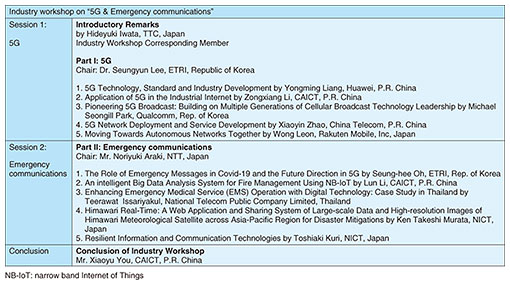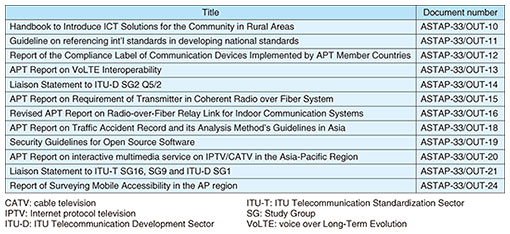 |
|||||
|
|
|||||
|
Global Standardization Activities Vol. 19, No. 11, pp. 65–68, Nov. 2021. https://doi.org/10.53829/ntr202111gls Standardization Activities in the Asia-Pacific Region—New Management Structure Approved at the 33rd Asia-Pacific Telecommunity Standardization Program (ASTAP) MeetingAbstractThe 33rd Asia-Pacific Telecommunity Standardization Program (ASTAP) meeting was held in June 2021 in an online format. ASTAP aims at strengthening standardization activities in the information and communication technology field in the Asia-Pacific Telecommunity and contributing to the establishment of international standards as a region. This article describes the main results of ASTAP-33 and the industry workshop held during the meeting. Keywords: APT, ASTAP, standardization 1. IntroductionThe Asia-Pacific Telecommunity (APT) is an international organization promoting information and communication technology (ICT) sector development in the Asia-Pacific region. It was established in 1979 and has 38 member countries [1]. The APT Standardization Program (ASTAP) was established in 1998 to promote standardization activities in APT [2]. The main objectives are to (1) contribute to international standardization by building a cooperative framework for standardization within the APT region, (2) foster standardization activists within the APT region and support skill development in the ICT field by members within the region, especially members of developing countries, and (3) make APT common proposals to international standardization organizations, such as the International Telecommunication Union (ITU), as regional standardization organizations. It is important to use ASTAP as a platform for building partnerships in the APT region and contributing to developing countries. It is also considered to be an important issue as a strategy for international collaboration on standardization in Japan. The 33rd ASTAP meeting (ASTAP-33) was held from June 7 to 11, 2021, and about 190 people from 17 member countries participated. At the meeting, an industry workshop on the fifth-generation mobile communication system (5G) and emergency communications was held, and 142 people participated. 2. New management structure of ASTAPThe terms of office of the chair and vice-chair of ASTAP are set to allow a maximum of two terms for each term of three years. ASTAP-32 was held in November 2020 at the timing of the expiration of the terms of office of the chair and vice-chairs of ASTAP. A new chair and vice-chairs were elected, and the work plans were confirmed at the meeting of the Working Group (WG), including the review of working methods in response to the worldwide spread of COVID-19 and the confirmation of the continuation of the organizational structure. Due to the COVID-19 pandemic, ASTAP-32 was held online for only 2 days, so the Expert Group (EG) meeting by technology field was not held, and substantive discussion on the new management structure started with ASTAP-33. Table 1 shows the organization structure of ASTAP and the new management structure. At ASTAP-32, Dr. Hyoung Jun Kim (Electronics and Telecommunications Research Institute (ETRI), Korea) was appointed as the new chair, who served as vice-chair until the previous meeting, and Dr. Hideyuki Iwata (The Telecommunication Technology Committee (TTC), Japan) and Dr. Xiaoyu You (The China Academy of Information and Communications Technology (CAICT), China) were appointed as vice-chairs. The continuation of the chairs and vice-chairs of the WG and EG was also confirmed and approved, respectively. At ASTAP-33, Mr. Kaoru Kenyoshi (National Institute of Information and Communications Technology (NICT), Japan) was newly appointed as vice-chair of WG PSC (Policy and Strategic Co-ordination), and Mr. Noriyuki Araki (NTT, Japan), author of this article, was appointed as chair of EG DRMRS (Disaster Risk Management and Relief System).
3. Industry workshopAt ASTAP-33, the ASTAP vice-chair organized an industry workshop on topics of interest to APT member countries. Based on the results of the questionnaire to APT member countries, ten presentations were made in each session on two topics of 5G and emergency communications from Japan, China, Korea, Thailand, etc. The commercial introduction of 5G has started in APT countries including Japan, China, and Korea, and it is a topic of interest for countries that are about to start commercialization. Natural disasters, such as typhoons and torrential rains, have occurred frequently not only in Japan but also throughout the APT region, and the social impact of COVID-19 continues to grow. Table 2 shows the program of the industry workshop.
Some of the presentations at the industry workshop were discussed in technically relevant EGs such as EG FN&NGN (Future Network and Next Generation Networks) and EG DRMRS, and new technical documents (APT Report) on related technologies were proposed as future work items. 4. Key output documentsAt ASTAP-33, input documents were discussed at WG and EG meetings, and ten APT Reports and two Liaison statements to other standards bodies were approved as output documents at the plenary meeting. Table 3 lists the main output documents (APT Reports and Liaisons) that have been approved.
Five APT Reports have been proposed by Japan and have led the development of documents, accounting for more than half the documents approved at this meeting. The following two documents were proposed by TTC where NTT serves as an expert committee member:
The former is a compilation of examples of ICT solution demonstration experiments in rural areas conducted in cooperation with partners in Asian countries and using the APT Project, etc. In this case, we added and revised a medical solution for tuberculosis in Myanmar. The latter indicates the importance of devising countermeasures by recording and analyzing accidents for the purpose of reducing traffic accidents. In this report, we investigated the situation of accident-record collection and analysis in Asian countries and summarized the record items and analysis methods as guidelines. 5. Future plansDue to the fact that ITU events, such as World Telecommunication Standardization Assembly and World Telecommunication Development Conference, have been postponed until 2022, and that there is a possibility that the schedule will be changed again depending on the COVID-19 situation, we determined that it would be difficult to decide the date and venue of ASTAP-34, and the schedule of ASTAP-34 has not yet been decided. It is hoped that the ASTAP meetings will be held in person to promote standardization activities in the Asia-Pacific region and use ASTAP more effectively as a forum for deepening cooperation with APT member countries. References
|
|||||












